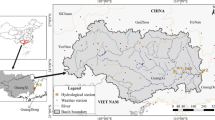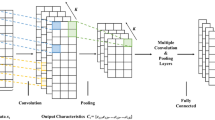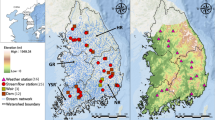Abstract
Accurate hydrological modeling is crucial for water resources management. Process-based models (PBMs) are physically interpretable yet cannot fully utilize large datasets. Deep learning models, especially Long Short-Term Memory (LSTM) networks, have exhibited remarkable simulation accuracy but lack physical interpretability. To integrate the strengths of PBMs and LSTM, this paper develops three hybrid models (HLUDC, HLBDC, and HLBDCT) by coupling LSTM with the HBV model. HLUDC incorporates the output of HBV into LSTM to enhance modeling capability. HLBDC connects the HBV model to an LSTM that estimates the parameters of HBV. HLBDCT further introduces time-varying parameters. Notably, the possible limitation of these models in data-scarce basins is unclear, as all models are trained with available observations. Therefore, we further evaluate the impact of the training data length on model stability. The hybrid models are applied to the daily streamflow simulation in the Jialing River Basin. The results indicate that the hybrid models effectively enhance streamflow simulation compared to benchmark models. HLBDCT performs the best with a 2.44%-13.43% improvement in Nash-Sutcliffe efficiency coefficient over HBV and LSTM, followed by HLBDC, while HLUDC performs the least. HLBDCT also performed well in simulating extreme flow. Both HLBDCT and HLBDC accurately estimate actual evapotranspiration without being trained on it, demonstrating their robust physical coherence. Furthermore, HBV, HLBDC, and HLBDCT exhibit higher stability when trained with different lengths of data compared to HLUDC and LSTM. Overall, this study provides a better understanding of the potential for using hybrid models to enhance hydrological simulation accuracy.








Similar content being viewed by others
Availability of data and materials
Not applicable.
References
Ayzel G, Heistermann M (2021) The effect of calibration data length on the performance of a conceptual hydrological model versus lstm and gru: A case study for six basins from the camels dataset. Comput Geosci 149:104708. https://doi.org/10.1016/j.cageo.2021.104708
Bárdossy A, Anwar F (2023) Why do our rainfall-runoff models keep underestimating the peak flows? Hydrol Earth Syst Sci 27(10):1987–2000. https://doi.org/10.5194/hess-27-1987-2023
Bergström S (1992) The HBV model-Its structure and applications. SMHI Reports RH 4, Swedish Meteorological and Hydrological Institute (SMHI), Norrköping, Sweden
Chen X, Wang S, Gao H et al (2022) Comparison of deep learning models and a typical process-based model in glacio-hydrology simulation. J Hydrol 615:128562. https://doi.org/10.1016/j.jhydrol.2022.128562
Duan Q, Sorooshian S, Gupta V (1992) Effective and efficient global optimization for conceptual rainfall-runoff models. Water Resour Res 28(4):1015–1031. https://doi.org/10.1029/91WR02985
Emami S, Parsa J (2020) Comparative evaluation of imperialist competitive algorithm and artificial neural networks for estimation of reservoirs storage capacity. Appl Water Sci 10(7):177. https://doi.org/10.1007/s13201-020-01259-3
Fang K, Kifer D, Lawson K, et al (2020) Evaluating the Potential and Challenges of an Uncertainty Quantification Method for Long Short-Term Memory Models for Soil Moisture Predictions. Water Resour Res 56(12):e2020WR028095. https://doi.org/10.1029/2020WR028095
Feng D, Jiangtao Liu, Kathryn Lawson, et al (2022) Differentiable, Learnable, Regionalized Process-Based Models With Multiphysical Outputs can Approach State-Of-The-Art Hydrologic Prediction Accuracy. Water Resour Res 58(10):e2022WR032404. https://doi.org/10.1029/2022WR032404
Frame JM, Kratzert F, Raney A II et al (2021) Post-processing the national water model with long short-term memory networks for streamflow predictions and model diagnostics. JAWRA J Am Water Resour Assoc 57(6):885–905. https://doi.org/10.1111/1752-1688.12964
Gupta HV, Kling H, Yilmaz KK et al (2009) Decomposition of the mean squared error and NSE performance criteria: Implications for improving hydrological modelling. J Hydrol 377(1–2):80–91. https://doi.org/10.1016/j.jhydrol.2009.08.003
Harris CR, Millman KJ, Walt SJvd, et al (2020) Array programming with NumPy. Nature 585(7825):357–362. https://doi.org/10.1038/s41586-020-2649-2
Hochreiter S, Schmidhuber J (1997) Long Short-term Memory. Neural Comput 9:1735–80. https://doi.org/10.1162/neco.1997.9.8.1735
Jiang P, Shuai P, Sun A et al (2023) Knowledge-informed deep learning for hydrological model calibration: an application to coal creek watershed in colorado. Hydrol Earth Syst Sci 27(14):2621–2644. https://doi.org/10.5194/hess-27-2621-2023
Jia X, Willard J, Karpatne A et al (2020) Physics-Guided Machine Learning for Scientific Discovery: An Application in Simulating Lake Temperature Profiles. https://doi.org/10.48550/arXiv.2001.11086, arXiv:2001.11086 [cs, eess]
Kratzert F, Klotz D, Shalev G et al (2019) Towards learning universal, regional, and local hydrological behaviors via machine learning applied to large-sample datasets. Hydrol Earth Syst Sci 23(12):5089–5110. https://doi.org/10.5194/hess-23-5089-2019
M. Vatanchi S, Etemadfard H, Maghrebi M et al (2023) A comparative study on forecasting of long-term daily streamflow using ann, anfis, bilstm and cnn-gru-lstm. Water Resour Manag 37:1–17. https://doi.org/10.1007/s11269-023-03579-w
Monteith JL (1965) Evaporation and environment. In: Symposia of the society for experimental biology, vol 19. Cambridge University Press (CUP) Cambridge, pp 205–234
Mu Q, Zhao M, Running SW (2011) Improvements to a modis global terrestrial evapotranspiration algorithm. Remote Sens Environ 115(8):1781–1800. https://doi.org/10.1016/j.rse.2011.02.019
Nash JE, Sutcliffe JV (1970) River flow forecasting through conceptual models part I - A discussion of principles. J Hydrol 10(3):282–290. https://doi.org/10.1016/0022-1694(70)90255-6
Parisouj P, Mohammadzadeh Khani H, Islam MF et al (2023) Ai-based runoff simulation based on remote sensing observations: A case study of two river basins in the united states and canada. JAWRA J Am Water Resour Assoc 59(2):299–316. https://doi.org/10.1111/1752-1688.13098
Paszke A, Gross S, Chintala S et al (2017) Automatic differentiation in PyTorch. In: Paper presented at 31st Conference on Neural Information Processing Systems, Long Beach, CA, USA
Peng A, Zhang X, Xu W, et al (2022) Effects of Training Data on the Learning Performance of LSTM Network for Runoff Simulation. Water Resour Manag 36(7). https://doi.org/10.1007/s11269-022-03148-7
Rahimzad M, Moghaddam Nia A, Zolfonoon H et al (2021) Performance comparison of an lstm-based deep learning model versus conventional machine learning algorithms for streamflow forecasting. Water Resources Management 35:1–21. https://doi.org/10.1007/s11269-021-02937-w
Razavi S (2021) Deep learning, explained: Fundamentals, explainability, and bridgeability to process-based modelling. Environ Model Softw 144:105159. https://doi.org/10.1016/j.envsoft.2021.105159
Reichstein M, Camps-Valls G, Stevens B et al (2019) Deep learning and process understanding for data-driven Earth system science. Nature 566(7743):195–204. https://doi.org/10.1038/s41586-019-0912-1
Roy DK (2021) Long Short-Term Memory Networks to Predict One-Step Ahead Reference Evapotranspiration in a Subtropical Climatic Zone. Environ Process 8(2):911–941. https://doi.org/10.1007/s40710-021-00512-4
Saft M, Peel MC, Western AW et al (2016) Bias in streamflow projections due to climate-induced shifts in catchment response. Geophys Res Lett 43(4):1574–1581. https://doi.org/10.1002/2015GL067326
Shen C, Appling AP, Gentine P et al (2023) Differentiable modelling to unify machine learning and physical models for geosciences. Nat Rev Earth Environ 4(8):552–567. https://doi.org/10.1038/s43017-023-00450-9
Tsai WP, Feng D, Pan M et al (2021) From calibration to parameter learning: Harnessing the scaling effects of big data in geoscientific modeling. Nat Commun 12(1):5988. https://doi.org/10.1038/s41467-021-26107-z
Watson DF, Philip GM (1985) A refinement of inverse distance weighted interpolation. Geo-processing 2:315–327. TitleTranslation:
Yilmaz KK, Gupta HV, Wagener T (2008) A process-based diagnostic approach to model evaluation: Application to the NWS distributed hydrologic model: PROCESS-BASED DIAGNOSTIC EVALUATION OF HYDROLOGIC MODEL. Water Resour Res 44(9). https://doi.org/10.1029/2007WR006716
Zhang J, Zhang M, Song Y et al (2021) Hydrological simulation of the Jialing River Basin using the MIKE SHE model in changing climate. J Water Clim Chang 12(6):2495–2514. https://doi.org/10.2166/wcc.2021.253
Funding
No funding was received for conducting this study.
Author information
Authors and Affiliations
Contributions
All authors contributed to the study conception and design. Material preparation, data collection and analysis were performed by Y Wei. R Wang helped perform the analysis. P Feng helped perform the analysis with constructive discussions. The first draft of the manuscript was written by Y Wei and all authors commented on previous versions of the manuscript. All authors read and approved the final manuscript.
Corresponding author
Ethics declarations
Ethics approval
The authors confirm that the submission is original work and not published elsewhere.
Consent to participate
All authors consented to participate in this study.
Consent for publication
All authors consented to publish this study.
Competing interests
The authors have no relevant financial or non-financial interests to disclose.
Additional information
Publisher's Note
Springer Nature remains neutral with regard to jurisdictional claims in published maps and institutional affiliations.
Supplementary Information
Below is the link to the electronic supplementary material.
Rights and permissions
Springer Nature or its licensor (e.g. a society or other partner) holds exclusive rights to this article under a publishing agreement with the author(s) or other rightsholder(s); author self-archiving of the accepted manuscript version of this article is solely governed by the terms of such publishing agreement and applicable law.
About this article
Cite this article
Wei, Y., Wang, R. & Feng, P. Improving Hydrological Modeling with Hybrid Models: A Comparative Study of Different Mechanisms for Coupling Deep Learning Models with Process-based Models. Water Resour Manage 38, 2471–2488 (2024). https://doi.org/10.1007/s11269-024-03780-5
Received:
Accepted:
Published:
Issue Date:
DOI: https://doi.org/10.1007/s11269-024-03780-5




